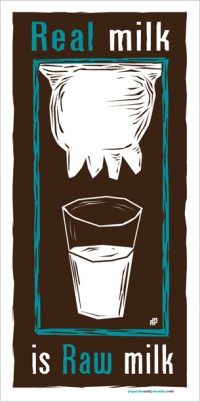What To Do When You Can’t Get Raw Milk
This post may contain affiliate links, including those from Amazon.com, which means we earn a small commission off your purchases. And here's the thing: We only mention services and products that we think are truly worth your attention, whether they're free, paid, or otherwise. This site relies on YOUR trust, so if we don't stand behind a product 110%, it's not mentioned. Period.
*************************************************
I've talked about my love of raw milk before. This nourishing, whole food is definitely a preference in our family.
But what to do when you can't get it?
Culture Your Milk



Fermented and cultured foods are essential for healing our bodies and keeping them healthy. If you can't get raw milk, culturing it can help restore the enzymes destroyed by pasteurization.
Yogurt and kefir are both easy ways to culture milk, and especially if you choose a thin, drinkable yogurt, you can use the milk in many of the same ways that you would if it wasn't cultured – on cereal, in baking, on oatmeal, in coffee, etc. The flavor of the milk won't be quite the same, but the final flavor will just depend on how you choose to culture it (e.g. piimä yogurt, milk kefir, etc.) and how long it cultures.
Here are a few suggestions of popular ways to culture milk:
- Milk kefir – doesn't thicken the milk as it cultures, so an excellent option
- Piimä – a drinkable yogurt from Scandinavia, thickens only slightly
- Balkan or Greek style yogurt – this is the type of yogurt you would likely find at your neighborhood grocery store. Click here to learn how to make balkan-style yogurts at home.
- Villi yogurt – a thick-enough-to-be-spoonable yogurt that cultures just by sitting on the counter
- Buttermilk – this is the traditional, slightly thick cultured buttermilk that many people prefer for baking and drinking over ice.
Not All Milk Is Created Equal
If you don't want to culture your milk, make sure you know the differences between the various types of milk available commercially so you can choose the variety that works best for you. You may have to look around for some varieties.
There's definitely an “order of preference” for which types of milk I prefer to buy, and those have to do with the types of pasteurization used. Conventional pasteurization destroys the good bacteria in the milk along with the pathogenic microorganisms, but there are other methods of pasteurizing that kill the pathogens without doing as much harm to the enzymes and beneficial bacteria. These are often labelled as “vat pasteurizing,” “slow pasteurization,” or “small batch pasteurization.”
Some small dairies also offer the non-homogenized milk, which is highly preferable as well. In the homogenization process, the fat proteins are forced through a fine sieve at very high pressure to keep the cream and fluid milk from separating, which creates a suspension and actually changes the molecular structures of those fat proteins. Multiple studies have linked homogenization with clogged arteries and other heart disease.
Here's our “hierarchy” of preference for types of milk:
- Raw Milk
- Slow-vat pasteurized, non-homogenized
- Slow-vat pasteurized, homogenized
- Conventional pasteurization, non-homogenized
- Conventional pasteurization, homogenized
- Ultra-High Temperature pasteurized (UHT) – not recommended in any circumstance (ironically, much organic milk is UHT – watch your labels carefully!)



